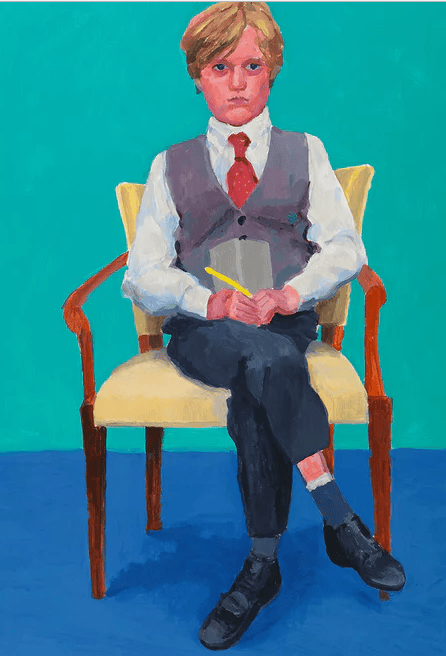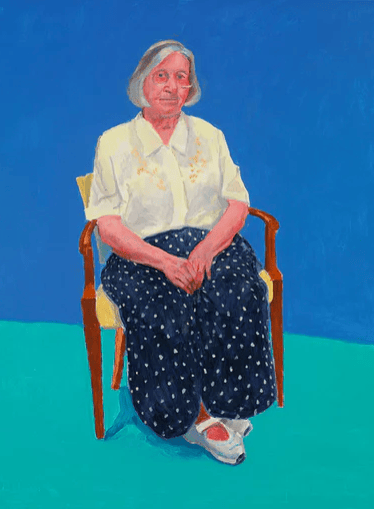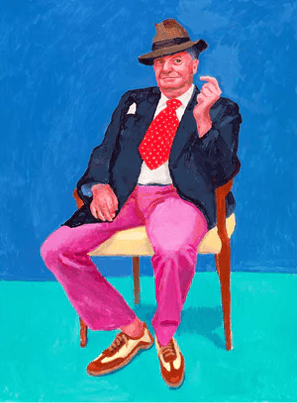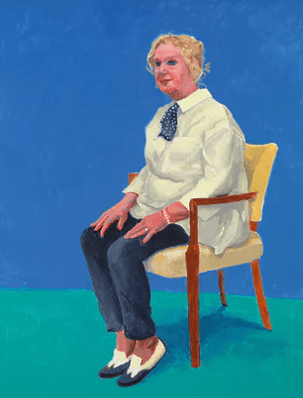Art can be presented in landscape, still life and portrait forms. David is renowned for his success in the landscape artistry back in 2012 and was now immersing himself in portraiture and still life. He made a comeback from a series of tragedies in 2013 by exhibiting his new body of work at the Guggenheim Museum Bilbao. David Hockey, 82 portraits, and still life uses creative vigor to present snapshots of the art world in LA as well as the people he has had relations in the past 50 years. The originality and creative potential allowed him to analyze and capture the personality of each subject. He moved away from the current trend in art where images of people are all over Facebook, Instagram, and other platforms. He avoided technology in this particular set of pictures by painting on canvas and placed them on exhibition for people to see. Thus, he was able to remain relevant in the arts industry despite avoiding technology. Through the 82 portraits, Hockney is trying to exercise his artistry limits and controls. Hence, he is determined to influence the perception of his viewers by triggering response-ability. Generally, this paper evaluates the painting of subjects to represent the views of an artist.
The sitters or subjects of his work were all family, friends, and acquaintances such as office staff, curators, fellow artists, and gallerists. The subjects were invited to his studio to produce a series of paints which play a significant role in revealing the importance of these characters in his life. The individual portraits took three days to complete and they all looked uniform. During the process, the sitters sat on the same spot in the studio, and in one particular yellow chair. The paints were painted on a canvas of the same size and placed side by side in an identical format relating to the time they were painted. The different individuals in the paintings were by themselves in their own portraits but formed a series. However, the portraits showed the difference when the studio varied in the manner in which the green floor and the blue backdrops were slightly changed and the difference in the fashion of the sitters. Despite the slight difference, he perceived these paintings as a single body of work. As a result, a psychological study of the paintings can indicate a lightening of his emotional state throughout the series, medium and format.
The originality and creative potential of an artist allow them to analyze and critique societal as well as aesthetic standards. For instance, the Simpsons’ creative potential in the contemporary animation in the postmodern world enabled them to succeed in the comedy industry. The Simpsons’ unique technique helped them to remain relevant in the comedy industry for many years after their first screening. Thus, through the television comedy the Simpsons, the bipartisan system and kinky nature of the society is reflected. It is able to bring out the issues in the education system, immigration, local authority, spirituality, homosexual rights and every significant aspect of the society in a funny way.
This is the same way Hockney aimed to use his prowess in color to capture the personality of each sitter through the bright light of California. Thus, his skillful paint handling was able to capture the uniformity of each of the painting’s elements which at the same time highlights the difference between the subjects and brings out their personalities. Despite the current trend where there is a lot of images of people on Facebook, Instagram, and other platforms, Hockney has set technology apart and painted portraits using his family, friends, and acquaintances as subjects except one which used fruits where the sitter canceled on the session. According to Cecile P. 858-874), most of the images made through technology have meaningless quality as compared to Mr. Hockney’s canvas paintings on the royal academy of arts in London exhibition of 82 portraits on October 2nd. Hence, he managed to remain relevant in the arts industry despite avoiding technology which is used by most people.
Through the exhibition of the 82 portraits, Hockey is not only painting his friends, family, and acquaintances but is also trying to exercise his limits and controls as an artist. He is determined to make a perception to his viewers through his close relations. Sitters and viewers are able to find familiar and unfamiliar likeness for others depending on their perceptions. Lawrence asserts that Hockney’s portraits make the viewer look at the paints in a very different manner because it does not paint to enhance the subjects in their own eyes but paints the subjects as he sees them.

Therefore, Hockney paints what he sees and he acknowledges that different people have different perceptions shaped by their own life’s experiences. Every time he captured a portrait he would find a different aspect of the sitter. This can be attributed by the fact that he had given them the freedom to decide their attires. Moreover, the pose and the chair’s positioning was left for the sitter to determine the most comfortable and natural position for him or herself. He only suggested different orientations of the chair but the final decision on the positioning was left entirely to the sitters. This was a good chance for them to express their characters and be captured as their natural selves.
Despite the uniformity in the portraits the painter seeks to bring out the individuality of his sitters. He wanted to bring out a different atmosphere through each portrait and he desired to accomplish this by having a different sitter bringing out their personalities. Therefore, Hockney is not just portraying his sitters but he is illustrating them through the use of eye-popping colors. In addition to the use of uniformity to distinguish and illustrate his sitters, he uses some form of inconsistencies. For instance, he uses the same color of denim but uses a different face color. He painted mineral turquoise on the eyes of Celia Birtwell’s and dabs her nose green but maintains the white and blue colors through her shoes and her bow. Also, he paints Jacob Rothschild’s skin extremely red and presents Baxter’s legs as very short.
Hockney is very realistic when it comes to details and he is showcasing a higher ability of fragrant, careful and coarse in his art. He offers his painting the same degree of attention showing his appreciation of democracy in portraiture. In essence, this is an indication that he is not interested in the individual touch but the general nuance brought by the 82 portraits. Detail in a picture has more significance than realized. It gives an opportunity to the reader to contemplate what the artist is trying to tell them through the picture. Symbols or pictures represent different ideas and an artist must be careful in the use of details in order to give room for the viewer to identify with his/her ideas. McCloud further asserts that people are often looking for human-like features in the objects that are nonliving and try to relate to them. Therefore, by making the objects on a portrait less detailed, an artist gives room for the people to relate to the objects and listen to the ideas which he/she is trying to communicate to them and understand.
Grange asserts that the way people see things is determined by their knowledge. He further asserts that academic, photographic reproduction and monetary values have distorted the way people see things. Many people relate what they see to the past but it is clear according to the assumptions of Berger that the past offers fewer conclusions for taking action. Therefore, it is essential that a viewer focuses on the composition of a portrait as it presents an emotional charge of the painting. The unforgettable contrast and the harmonious fusion transfers the emotions which are provoked by the painting from the lived experiences to the appreciation of art.
The sequence of the portraits leads the viewers from the fiction to a real life which brings along a response-ability of the viewers. Therefore, this can be considered an ethical charge which calls for a response, responsibility, aesthetic valuation and ethical judgment. Thus, this particular exhibition created an immersive and intense installation which reexamines the role of painting a portrait in the modern age where photo portraits and selfies take the center stage in the society. The way people perceive work of art or visual art has changed with the age of mechanical reproduction brought about by modernity. An original painting has an aura which cannot be found in modern art lost through the process of mechanical reproduction of the art. The authenticity and originality of art remain the same in a painting than in a photograph or film. This means that a painting has authority on people’s perceptions and loss of aura gives room for the popularization of art.
We can do it today.
Benjamin mentioned that work of art have ever since been reproduced. And as a result, it has led to the manipulation and reproduction of the art work. He believes that this has really devalued the credibility of art in terms of authenticity and creativity. Nonetheless, the traditional and ritualistic concepts are considered to be more valuable in the development and creation of art work. As a result of mechanical reproduction, it has created new ways for various types of recreations. It has drastically changed the art expectations as well as the impacts and the role of art.
David Hockney’s 82 portraits and 1still life is among the most successful works of portraiture and still life. A series of tragedies led David to start painting still life and portraiture in Los Angeles. He used originality and creativity to present unique works of art featuring people he had had relations in the past 50 years. Thus, despite not using technology his originality and creative potential enabled him to analyze the characters of his sitters and paint them the way he saw them. He also exercised his artistry limits and controls through these painting by trying to influence the perception of his viewers by triggering response-ability.
Appendix

John Baldessari, 12th Dec 2013

Rufus Hale, 23-25 Nov 2015.

Margaret Hockey, 14th, 15th, and 16th Aug 2015

Barry Humphries, 26-28 March 2015

Celia Birtwell, 31Aug-4 Sep 2015
- Barringer, Tim, and Edith Devaney. David Hockney: 82 Portraits and One Still-life. New York City: Harry N. Abrams, 2017.
- Benjamin, Walter. The Work of Art in the Age of Mechanical Reproduction. online : CreateSpace Independent Publishing Platform, 2016.
- Grange, Ashley la. Basic Critical Theory for Photographers. New York: CRC Press, 2013.
- Hockney, David. David Hockney : a bigger book. Cologne: Taschen, 2016.
- Maidment, Simon, Barbara Bolt, and Edith Devaney. David Hockney: Current. London: Thames & Hudson, 2017.
- McCloud, Scott. Understanding Comics. New York: HarperCollins, 1994.
- Price, Brian. On Michael Haneke:Contemporary approaches to film and television series. Detroit: Wayne State University Press,, 2010.
- Richardson, Kelly L. “”Simpsons Did It!”: South Park and The Intertexuality of Contemporary Animation.” Studies in American Humor 3, no. 17 (2008): 19.
- Waltonen, Karma, and Denise Du Vernay. The Simpsons in the Classroom: Embiggening the Learning Experience with the Wisdom of Springfield. San Joaquin Valley: McFarland, 2010.
